When it comes to defending the skies, few systems command as much global attention and respect as the S-400 Air Defence System. Engineered by Russia’s Almaz-Antey, the S-400 isn’t just another surface-to-air missile platform — it’s a multi-layered aerial shield capable of detecting, tracking, and neutralising everything from enemy aircraft to ballistic and cruise missiles with unmatched speed and accuracy.
Adopted by military powerhouses such as China, Turkey, and India, the S-400 represents a significant shift in how nations protect their airspace. In India, this cutting-edge system is often likened to a modern-day ‘Sudarshan Chakra’ — a metaphorical weapon of divine precision and unstoppable force.
But what makes the S-400 truly revolutionary?
How does it track threats over 600 km away?
Why is it feared by fighter pilots and strategists alike?
And what strategic edge does it offer to nations like India in an increasingly volatile geopolitical landscape?
In this article, we unpack everything you need to know — from technical specifications and working mechanisms to deployment cost, global comparisons, and why the S-400 is reshaping the very concept of aerial dominance in 21st-century warfare.
What Is the S-400 Air Defence System?
The S-400 Air Defence System, also known as Triumf, is a next-generation surface-to-air missile (SAM) platform developed by Russia’s Almaz-Antey to neutralise aerial threats with unmatched precision. Designed for layered air defence, the S-400 can intercept a wide range of threats—including fighter jets, ballistic missiles, cruise missiles, UAVs, and even stealth aircraft—at varying altitudes and distances.

Key Capabilities That Set the S-400 Apart:
- Multi-target tracking: Can detect and engage up to 80 targets simultaneously
- Flexible engagement envelope: Strikes targets from low-flying drones to hypersonic missiles
- Incredible range: Detects threats at up to 600 km; engages at up to 400 km
- Versatile missile types: Uses four different missile classes (from 9M96E to 40N6E) to optimise for short, medium, and long-range attacks
- High-speed interception: Missiles travel at up to Mach 4.8 (approx. 5,900 km/h), neutralising threats travelling at over 1,000 m/s
This system isn’t just about range—it’s about precision, reaction time, and threat identification in real-time. The S-400 includes:
- Advanced radar arrays for 360° detection
- Autonomous command and control vehicles
- Mobile missile launch platforms
- Fully networked fire control units
Thanks to this integrated setup, the S-400 creates a protective dome capable of shielding entire cities, military bases, or strategic infrastructure from enemy strikes.
No surprise, then, that it’s widely regarded as one of the most formidable air defence systems in the world, often cited as a direct counter to U.S.-made Patriot and THAAD systems.
Development and History of the S-400 Missile System
The S-400 Air Defence System, developed by Russia’s Almaz-Antey, represents a leap forward in air defence technology. Officially entering service in 2007, the S-400 was designed to replace the ageing S-300 series and counter a new era of threats, including stealth aircraft, supersonic missiles, and long-range strategic bombers.
This advanced system wasn’t just an upgrade; it was a strategic response to emerging challenges posed by fifth-generation fighter jets like the F-22 Raptor and F-35 Lightning II. As stealth technology improved globally, Russia recognised the need for a defence shield that could detect and neutralise threats with low radar signatures—and the S-400 was the answer.
Evolution Through Upgrades
Since its initial deployment, the S-400 has undergone multiple technological enhancements, making it more adaptable to modern warfare. Key upgrades include:
- Improved radar cross-section tracking to detect stealth platforms
- Integration of the 40N6E missile with a range up to 400 km
- Enhanced target discrimination algorithms to reduce false positives
- Modular architecture for rapid mobility and deployment
A Global Demand Driven by Regional Threats
The S-400’s ability to track stealth aircraft, simultaneously engage multiple targets, and operate in electronic warfare conditions has made it one of the most sought-after air defence systems globally. Nations like India, China, and Turkey have chosen the S-400 not only for its technical superiority, but also for its strategic value in countering adversaries equipped with cutting-edge aerial platforms.
For countries like India, which face regional tensions with both China (J-20 stealth fighter) and Pakistan (F-16s and UAVs), the S-400 provides a much-needed layer of protection against high-speed and low-observable threats.
India-Russia S-400 Missile Deal: Cost, Strategic Impact, and CAATSA Concerns
India’s purchase of the S-400 Triumf missile system from Russia marked one of the most significant defence acquisitions in recent history. The $5.43 billion deal, signed in 2018, covers the procurement of five full S-400 regiments, each capable of neutralising multiple aerial threats simultaneously across vast distances.
While the S-400 is a technological marvel, the transaction also sparked geopolitical tremors, especially due to the CAATSA (Countering America’s Adversaries Through Sanctions Act). Despite pressure from the United States, India upheld its strategic autonomy in defence procurement, emphasising the S-400’s critical role in countering both Chinese stealth aircraft and Pakistani missile systems.
Each S-400 regiment includes radar units, command vehicles, launch platforms, and a mix of interceptor missiles, providing comprehensive, long-range air defence. The system is not just a tactical asset, but a strategic deterrent that enhances India’s regional dominance and balances Russia–India military ties against growing U.S.–India cooperation.
Strategic Advantages of the S-400 System to India
India’s acquisition of the S-400 Air Defence System from Russia marks a significant leap in its aerial defence capabilities, reshaping the power dynamics in South Asia. Widely seen as a strategic game-changer, the S-400 provides India with the ability to detect, track, and neutralise multiple aerial threats well before they enter Indian airspace.
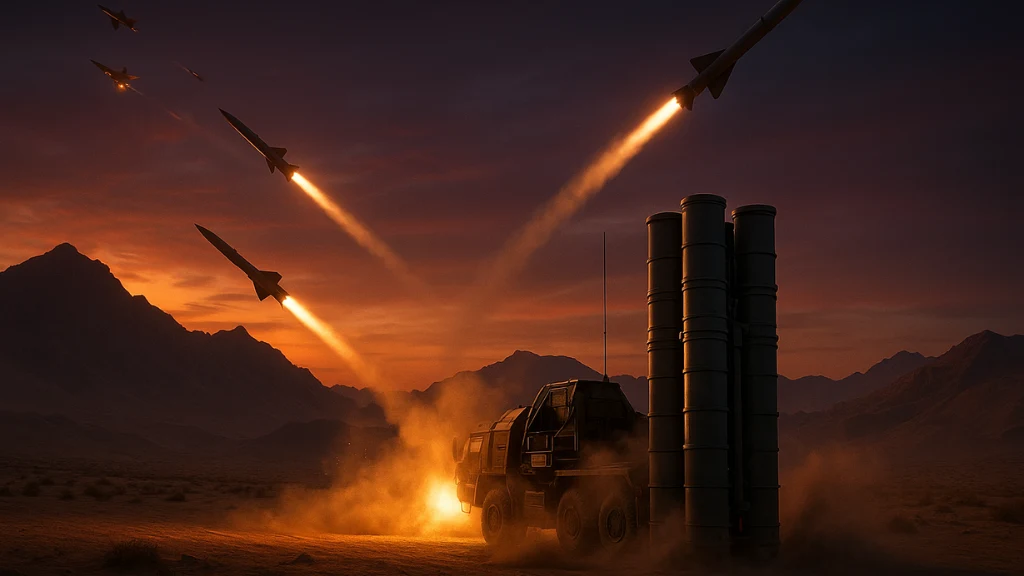
Strengthening India’s Defence Against Regional Threats
With rising tensions along the borders with China and Pakistan, India’s need for a multi-layered missile defence system is more critical than ever. The S-400 addresses this challenge by offering:
- A detection range of up to 600 km, giving early warning against stealth aircraft, drones, and ballistic missiles.
- The ability to engage multiple targets simultaneously, tracking and intercepting up to 80 threats at once.
- Effective interception at both high altitudes and low levels, making it suitable for a variety of threats across different terrains.
This makes the S-400 a key deterrent against:
- Pakistan’s F-16 fighter jets and armed UAVs
- China’s J-20 stealth aircraft and long-range missile systems
Designed for India’s Terrain and Mobility Needs
India’s varied geography—from the desert frontlines in Rajasthan to the high-altitude borders of Ladakh—requires a defence system that is not only powerful but also highly mobile and adaptable. The S-400 meets these needs with:
- Road-mobile launchers that can move quickly across regions
- Autonomous radar and command vehicles for decentralised operations
- Quick deployment and repositioning ability, ensuring fast response in volatile zones
This enables India to rapidly deploy the system in response to real-time threats and maintain air dominance across critical strategic locations.
Strategic Deployment of the S-400 in India: Border Shield Against Pakistan and China
India’s deployment of the S-400 air defence system isn’t just about acquiring cutting-edge missile technology—it’s a calculated move to secure its most vulnerable frontiers. The S-400 regiments are strategically positioned across Punjab, Rajasthan, Arunachal Pradesh, and Ladakh, forming a defensive wall along the Line of Control (LoC) with Pakistan and the Line of Actual Control (LAC) with China.

These regions have witnessed rising tensions and frequent aerial intrusions, making the S-400 deployment in India crucial for maintaining airspace superiority. With a detection range of up to 600 km, these missile batteries can track enemy fighter jets, drones, and ballistic missiles before they breach Indian airspace, providing valuable response time and threat assessment.
By installing the S-400 in geopolitically sensitive zones, India aims to deter cross-border aggression, protect key military bases and cities, and achieve a layered air defence system that integrates with indigenous solutions like the Akash missile system and Ballistic Missile Defence (BMD) shield.
How the S-400 Missile System Detects and Tracks Targets
The backbone of the S-400 Air Defence System’s detection capability lies in its advanced, multi-frequency radar network, designed to spot threats from hundreds of kilometres away, even if they are stealth-equipped or flying at low altitudes.
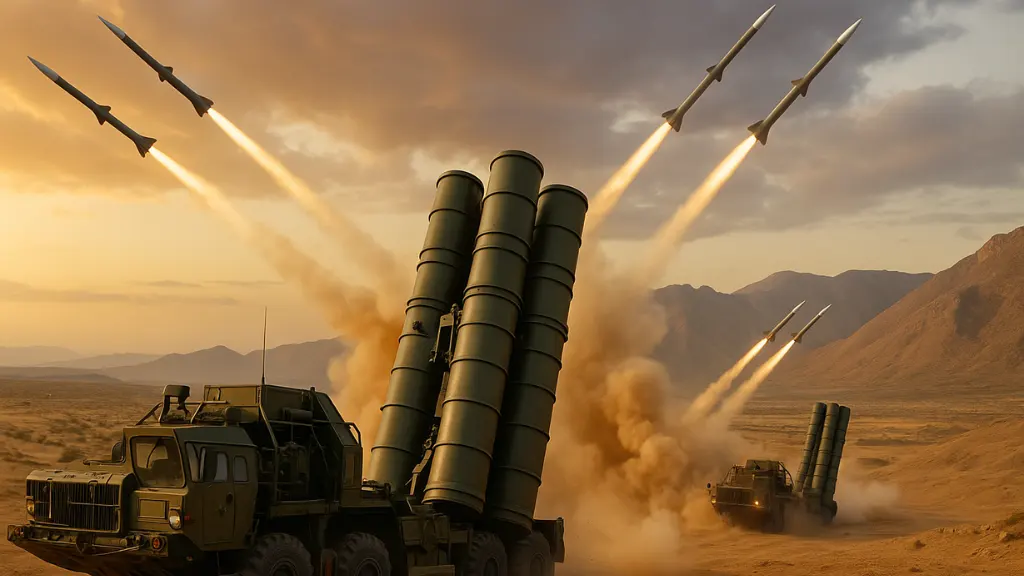
Long-Range Surveillance with Big Bird Radar
At the core of target detection is the 91N6E ‘Big Bird’ radar, a long-range surveillance system capable of acquiring targets at distances up to 600 km. It serves as the first line of defence, scanning wide airspace and flagging any potential threats—be it a fighter jet, cruise missile, UAV, or ballistic missile.
Engagement with Grave Stone Radar
Once a threat is identified, the system hands over tracking and engagement tasks to the 92N6E ‘Grave Stone’ radar, a fire-control radar responsible for:
- Precise tracking of the target’s movement
- Missile guidance throughout the interception phase
- Command and control synchronisation with mobile launchers
Built to Outsmart Stealth and Jamming
What makes the Russian S-400 system especially formidable is its use of multi-band radar frequencies, which allow it to detect and track low-observable targets like stealth aircraft (e.g., the F-22 and J-20) that typically evade conventional radar systems.
Moreover, these radar units are resistant to electronic jamming and countermeasures, ensuring continuous target lock even in high-threat or electronic warfare environments.
S-400 and Its Impact on India-Pakistan Tensions
Since 6th May, India’s deployment of the S-400 Air Defence System—also dubbed the ‘Sudarshan Chakra’—has drawn intense regional focus amid rising tensions with Pakistan. As both nations strive to modernise their military capabilities, the S-400 has emerged as a pivotal asset in India’s defence posture, offering a decisive edge in countering aerial threats.
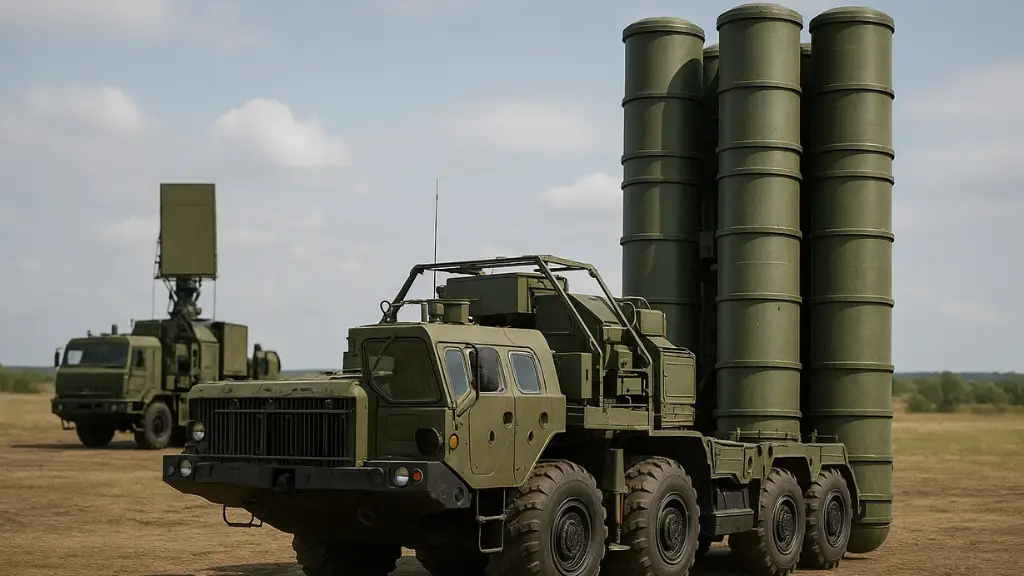
A Shift in the Balance of Power
India’s acquisition of the S-400 system from Russia has triggered concern in Islamabad. The system’s ability to detect, track, and intercept fighter jets, UAVs, cruise missiles, and ballistic threats makes it one of the most formidable platforms in South Asia.
Pakistan views this as a strategic imbalance, especially as India strengthens its ability to neutralise airborne attacks before they breach its airspace.
Neutralising Pakistan’s Missile Threats
One of the standout capabilities of the S-400, or ‘Sudarshan Chakra’, is its ability to intercept long-range threats like Pakistan’s Fateh-1 and Fateh-2 missiles, which have been used in the past to target critical Indian infrastructure and military assets.
- The S-400’s multi-layered missile defence system ensures high-probability interception, with reports suggesting close to 100% success rates during simulations and real-time tests.
- This significantly reduces the effectiveness of Pakistan’s missile inventory, challenging the credibility of its offensive posture.
Even Pakistan’s Chinese-origin PL-50 missile, long considered a reliable component of its arsenal, struggles to bypass the S-400’s integrated radar and fire control systems. The system’s advanced tracking algorithms and high-speed interceptors make it extremely difficult for enemy missiles to evade engagement.
Strategic Deterrence Through Technological Superiority
What gives the S-400 a geopolitical edge is its multi-layered interception capability, combining:
- Long-range detection
- 360-degree radar coverage
- High-precision guidance systems
This creates a protective shield over strategic zones, especially in border areas like Punjab, Rajasthan, and Jammu & Kashmir, where the threat of missile strikes remains high.
The deployment of the S-400 on Indian soil is more than a military upgrade—it’s a message of deterrence. Its presence significantly complicates Pakistan’s planning of any potential cross-border aerial aggression.
How the S-400 Missile System Operates in Real Combat Scenarios
In an actual combat environment, the S-400 Air Defence System transforms from a passive surveillance tool into an active shield of strategic defence, capable of responding to high-speed aerial threats in a matter of seconds. Its automated command and control systems ensure a rapid, calculated, and precise interception—even in high-pressure wartime conditions.
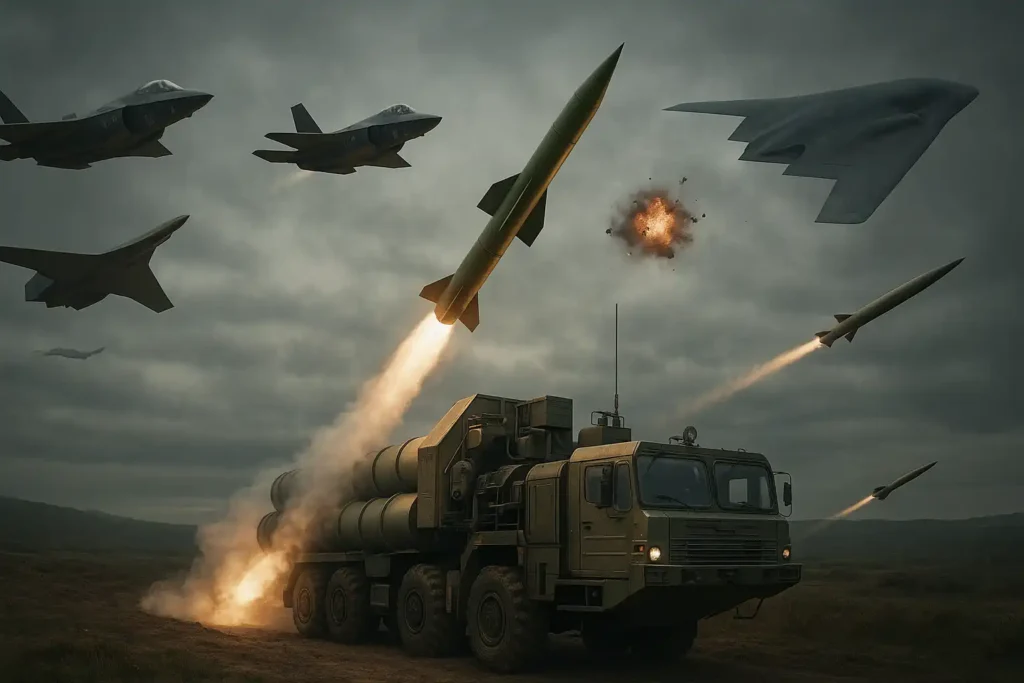
Step-by-Step: How the S-400 Responds in Battle
When a hostile aircraft, drone, or missile breaches its radar envelope, here’s what happens in real-time:
- Early Detection:
The 91N6E Big Bird radar scans for threats up to 600 km away, identifying the object’s speed, altitude, and direction. - Target Lock & Threat Assessment:
The 92N6E Grave Stone radar takes over, locking onto the threat and calculating its intercept point with pinpoint accuracy. - Engagement Decision:
The command and control centre evaluates the threat type and chooses the most suitable missile (short, medium, or long-range) for interception. - Missile Launch:
A surface-to-air missile (SAM)—such as the 48N6 or 40N6E—is launched from a mobile battery, guided in real-time by radar signals. - Precision Kill:
The missile adjusts its path mid-flight to ensure a direct hit, neutralising the threat before it reaches its target zone.
Real-World Combat Deployment: The Syrian Example
The S-400 system has been battle-tested, notably in Syria, where it was deployed by Russian forces to safeguard airspace around critical zones like Latakia. In this conflict environment:
- The S-400 successfully monitored and controlled contested skies.
- It tracked NATO and Israeli aircraft, acting as both a deterrent and an enforcement system.
- Its surveillance capabilities extended beyond Syrian airspace, giving Russia a strategic advantage across the Eastern Mediterranean.
This real-world deployment reinforced the S-400’s reputation as a layered, high-precision defence mechanism—not just theoretical in capability, but proven on the battlefield.
S-400’s Capabilities: Can It Detect and Intercept Advanced Threats?
One of the reasons the S-400 Air Defence System is considered a global benchmark in missile defence is its proven ability to detect, track, and intercept the most advanced aerial threats, including stealth aircraft and tactical ballistic missiles.
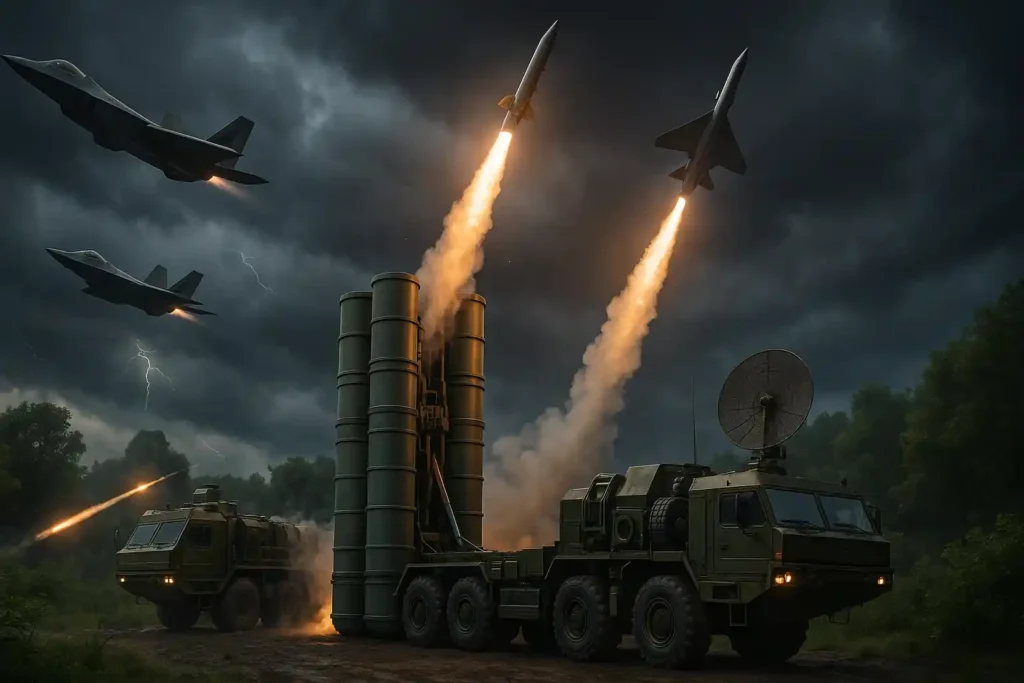
Below are some of the most frequently asked questions (FAQs) about its capabilities, answered clearly and backed by technical insights.
Can the S-400 detect the F-35 stealth fighter?
Yes, the Russian S-400 system is designed to detect and track low-observable aircraft such as the F-35 Lightning II. It’s 91N6E Big Bird radar, paired with high-frequency multi-band tracking systems, enhances its ability to identify and engage stealth aircraft—even those designed to evade conventional radar.
Can the S-400 track the F-22 Raptor?
Absolutely. The F-22 Raptor is known for its stealth, but the S-400’s Grave Stone radar (92N6E) and passive detection systems allow it to lock on to stealth profiles based on infrared, electronic signatures, and radar reflections. This gives the S-400 a major edge in detecting high-end fifth-generation fighters.
Can the S-400 detect the B-2 Spirit stealth bomber?
Yes. Despite the B-2’s radar-absorbing design, the S-400’s long-range radars can track large, slow-moving stealth aircraft like the B-2 bomber. The system’s ability to operate across multiple frequency bands allows it to penetrate stealth coatings and identify threats with low radar signatures.
Can the S-400 shoot down ATACMS missiles?
Yes, the S-400 missile system is specifically engineered to intercept short-range ballistic missiles (SRBMs) such as the ATACMS (Army Tactical Missile System). Using interceptor missiles like the 9M96 and 48N6, it can neutralise threats travelling at high speeds and various altitudes.
Can the S-400 intercept ballistic missiles in general?
Definitely. One of the core strengths of the S-400 Triumf is its ability to engage medium and long-range ballistic missiles, making it a vital part of a nation’s multi-layered air defence network. It uses a combination of long-range radar detection, target discrimination, and precise interceptor guidance to take down incoming missiles before they reach their intended targets.
Summary: Why the S-400 Is Considered Battle-Ready for Modern Threats
Whether it’s fifth-generation stealth fighters, strategic bombers, or ballistic missile threats, the S-400’s advanced sensors and missiles allow it to serve as an all-in-one defence platform. This unmatched versatility is why countries like India, China, and Turkey have invested in the system despite geopolitical pressures.
Components of the S-400 System: Radar, Launchers, and Command Units
The S-400 Air Defence System is not a single weapon but a highly integrated defence network, composed of multiple subsystems working together to detect, track, engage, and neutralise airborne threats with precision and speed.

Here’s a breakdown of its key components:
91N6E ‘Big Bird’ Surveillance Radar
- Provides long-range early warning and target detection up to 600 km
- Capable of identifying multiple targets simultaneously, including stealth aircraft
92N6E ‘Grave Stone’ Engagement Radar
- Serves as the fire control radar
- Tracks specific targets and provides real-time guidance to interceptor missiles
Command and Control Centre
- Houses integrated computerised systems
- Coordinates radar data, threat analysis, and launch authorisation for seamless operations
5P85TE2 & 5P85SE2 Mobile Launchers
- Equipped with vertical launch tubes for quick and versatile missile launches
- Highly mobile, allowing for rapid deployment across conflict zones
Missile Variants (By Range and Role)
- 40N6: Long-range missile with a range of up to 400 km
- 48N6: Mid-long range missile (up to 250 km)
- 9M96E2: Medium-range missile (up to 120 km)
- 9M96E: Short-range missile (up to 40 km)
These missile types enable the S-400 to intercept threats at varying distances and altitudes, making it a truly layered defence solution.
Advanced Technologies in the S-400 System
What makes the Russian S-400 system stand out globally is the technological sophistication embedded into each component. Designed for modern air warfare, the system leverages several innovations to maintain superiority in both defensive and contested environments.
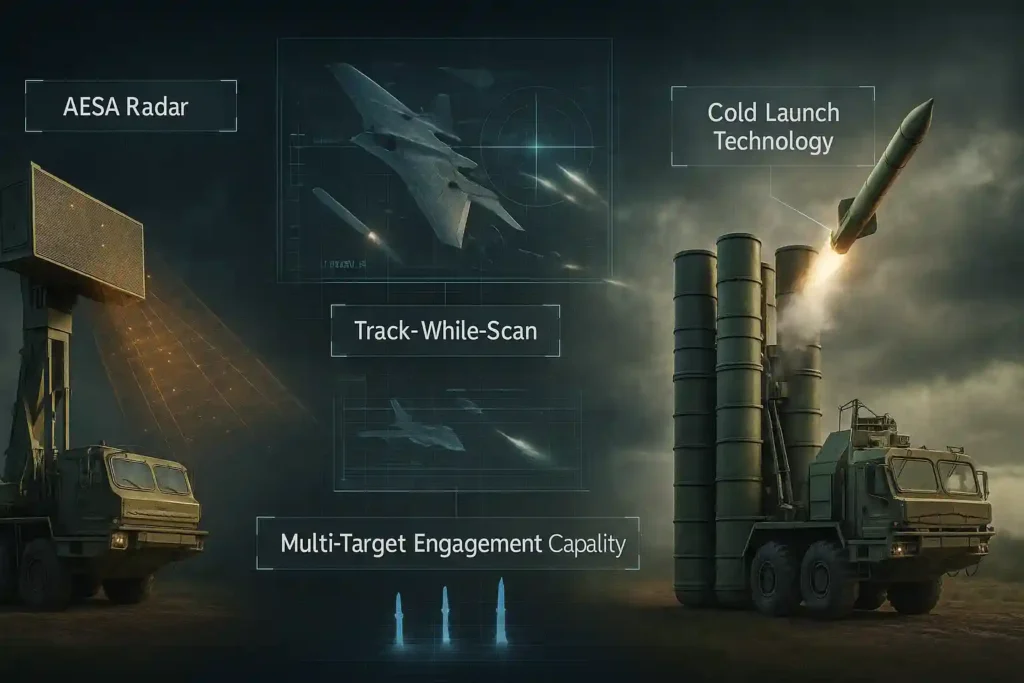
Active Electronically Scanned Array (AESA) Radar
- Ensures high-resolution detection
- Operates in multiple frequency bands to detect stealth aircraft
Track-While-Scan (TWS) Algorithms
- Allows the system to track and prioritise multiple targets simultaneously
- Crucial for engaging multiple threats in a real-time combat situation
Cold Launch Technology
- Missiles are ejected from the launcher before ignition
- Reduces the radar signature and enhances launcher safety and survivability
Multi-Target Engagement Capability
- The system can engage up to 80 targets simultaneously
- Automatically selects the appropriate missile based on threat type, speed, and altitude
Why This Matters
These components and technologies make the S-400 air defence system one of the most versatile and resilient missile defence platforms in the world. Whether it’s deployed in the mountains of Ladakh or along the borders of Punjab, the system is built to neutralise fast-moving, low-RCS (Radar Cross Section) threats under electronic warfare conditions.
Global Comparison: How the S-400 Stacks Up Against Other Air Defence Systems
The S-400 Triumf, developed by Russia, is often benchmarked against other top-tier missile defence systems like the US Patriot PAC-3, THAAD, Israel’s David’s Sling, and China’s HQ-9. Each of these systems serves a different operational purpose and excels in specific threat environments.
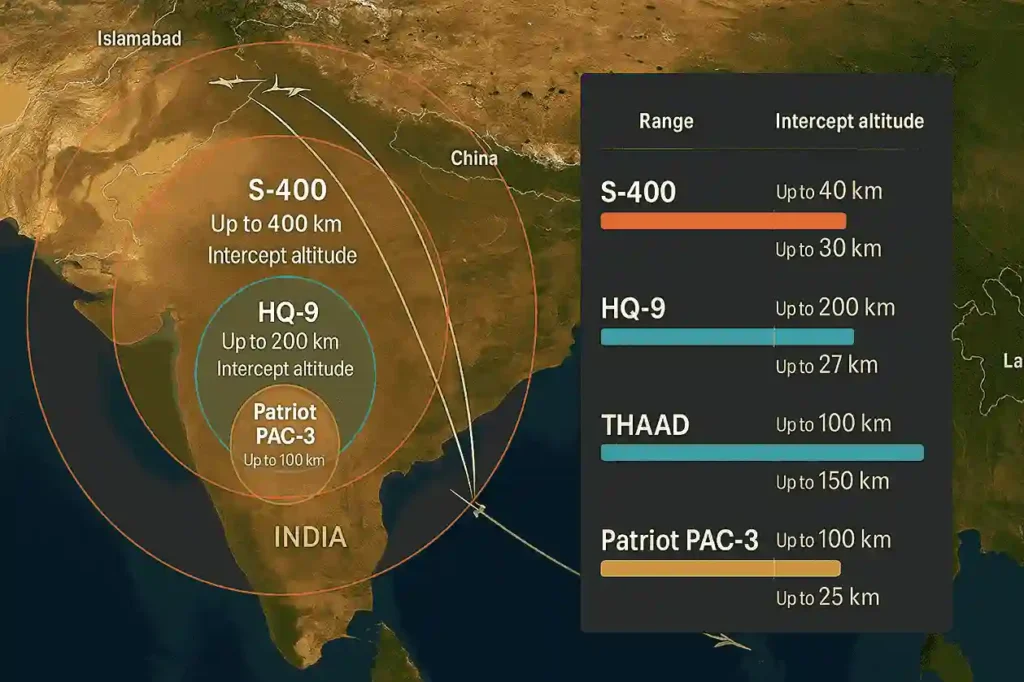
Let’s break down how the S-400 compares across key metrics such as range, target types, missile variety, and battlefield flexibility.
S-400 vs Patriot PAC-3 (USA)
| Feature | S-400 Triumf (Russia) | Patriot PAC-3 (USA) |
|---|---|---|
| Range (Aircraft) | Up to 400 km | Approx. 160 km |
| Range (Missiles) | Up to 60 km | Approx. 20–35 km |
| Simultaneous Targets | Up to 36 | Approx. 9 |
| Threats Intercepted | Aircraft, cruise missiles, ballistic missiles, and stealth jets | Aircraft, ballistic missiles |
| Missile Types | 4 missile variants for layered defence | Single missile type (PAC-3 MSE) |
| Radar Range | Detection up to 600 km | Shorter radar range (~150 km) |
Verdict: The S-400 offers greater versatility, longer detection range, and multi-layered threat engagement, while the PAC-3 is specialised in point defence against incoming missiles.
S-400 vs HAAD (USA)
| Feature | S-400 Triumf | THAAD (USA) |
|---|---|---|
| Primary Role | Multi-role air defence | Exo-atmospheric interception of ballistic missiles |
| Range | Up to 400 km (aircraft) | Approx. 200 km (missiles) |
| Threat Types | Aircraft, UAVs, cruise, and ballistic missiles | Ballistic missiles only |
| Deployment Flexibility | Versatile in battlefield conditions | Primarily static or semi-mobile use |
Verdict: While THAAD is excellent for high-altitude ballistic missile defence, the S-400 is more suitable for diverse battlefield scenarios, engaging multiple threat types.
S-400 vs David’s Sling (Israel)
| Feature | S-400 Triumf | David’s Sling |
|---|---|---|
| Range | Up to 400 km | Approx. 70–300 km |
| Target Types | Cruise missiles, stealth aircraft, and ballistic missiles | Tactical rockets, UAVs, and short-range missiles |
| System Role | Part of Russia’s strategic deterrence | Integrated in Israel’s Iron Dome–Arrow shield |
Verdict: The S-400 is superior in long-range interception and multi-target engagement, while David’s Sling is tailored for regional, mid-range tactical defence.
S-400 vs HQ-9 (China)
| Feature | S-400 Triumf | HQ-9 (China) |
|---|---|---|
| Technology Origin | Russian, proven in multiple theatres | Based on the Russian S-300, indigenised |
| Missile Variety | Four missile types for tiered defence | Limited to one or two missile types |
| Combat Validation | Tested in Syria and strategic deployments | Limited battlefield validation |
| Export Status | Sold to India, Turkey, China (limited units) | Primarily used within China |
Verdict: The HQ-9 offers localised defence but lacks the global combat validation and missile diversity of the S-400.
Final Analysis
While each air defence system serves a strategic role based on its nation’s requirements, the S-400 remains the most versatile and globally adopted system for countries seeking a comprehensive, long-range, multi-target solution. Its combination of deep radar reach, stealth countermeasures, and multi-layered defence sets it apart on the modern battlefield.
Future Prospects of the S-400 Missile System
As global security challenges grow more complex, the S-400 Air Defence System is poised to remain a central pillar in advanced air defence strategies worldwide. With its unmatched flexibility, long-range coverage, and multi-target engagement capabilities, the S-400 continues to evolve in response to next-generation threats.
Staying Ahead Through Technological Evolution
Russia’s defence industry continues to invest in cutting-edge missile propulsion, tracking algorithms, and radar systems. These innovations are expected to further enhance the S-400’s ability to detect and intercept stealth aircraft, UAVs, cruise missiles, and hypersonic threats in the years ahead.
- Next-gen radar upgrades will improve low-RCS detection
- Extended-range missile variants may exceed the current limits of 400 km
- AI-assisted threat recognition could enable faster response and higher interception accuracy
Growing Global Interest and Integration Potential
More countries are expressing interest in acquiring the S-400, not just for its standalone performance but for its potential to be integrated into broader, multi-layered air defence systems. Nations like India, Turkey, and China are already deploying the system alongside indigenous platforms and early warning networks.
In the future, S-400 systems may:
- Operate in network-centric warfare environments
- Be combined with satellite-based threat detection
- Interface with fifth-generation aircraft, drones, and space surveillance systems
Adapting to New-Age Warfare
With the rise of:
- Drone swarms
- Loitering munitions
- Hypersonic glide vehicles
…defence systems must adapt rapidly. The S-400 is expected to receive software upgrades and hardware extensions to stay relevant in this changing combat landscape.
Its modular design makes it ideal for continuous updates, ensuring that it remains a strategic asset in both peacetime deterrence and wartime engagement.
Final Thought
In a world where airspace dominance is increasingly vital, the S-400 missile system is more than just a current solution—it’s a future-ready platform. Its blend of technical sophistication, global adoption, and upgrade potential ensures it will remain the backbone of national defence systems for years to come.
S-400 and Emerging Threats: Hypersonic Missiles and Drones
As warfare enters a new era driven by hypersonic weapons and autonomous drone technology, traditional air defence systems face increasing pressure to evolve. The S-400 Air Defence System, however, has been continuously upgraded to counter these next-generation aerial threats, making it one of the few global systems that remains both relevant and resilient.
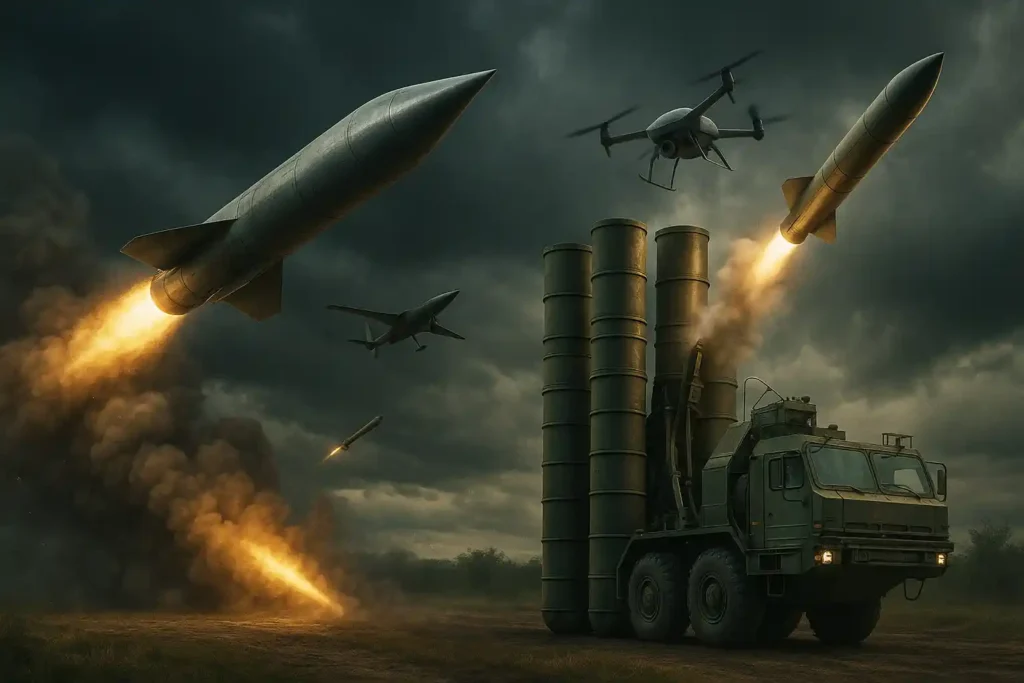
Hypersonic Missiles: A New Frontier in Air Defence
Hypersonic missiles, capable of travelling at speeds above Mach 5, pose a serious challenge to conventional missile defence systems. Their speed, manoeuvrability, and unpredictable flight paths make them extremely difficult to intercept.
However, the Russian S-400 missile system has incorporated several key upgrades to counter this threat:
- Advanced radar modules with extended tracking bandwidth for high-speed object detection
- Rapid-reaction intercept algorithms to shorten decision-making time
- Missile variants optimised for high-speed engagement, capable of altering course mid-flight to intercept fast-moving targets
These enhancements allow the S-400 to track and engage hypersonic glide vehicles (HGVs) during vulnerable phases of their trajectory, significantly reducing the risk posed by such advanced missiles.
Drones and UAVs: Adapting to the Swarm Threat
The rise of Unmanned Aerial Vehicles (UAVs) and combat drones has transformed the battlefield. From surveillance to precision strikes, drones now play a major role in modern military operations.
The S-400 system has been reconfigured to:
- Detect low-altitude, low-RCS (Radar Cross Section) drones
- Engage multiple small targets simultaneously through multi-frequency radar systems
- Integrate with electronic warfare tools to jam or disable swarm drones before they reach critical airspace
Whether it’s a single high-speed reconnaissance drone or a coordinated drone swarm, the S-400’s versatile radar and fire-control systems are designed to respond swiftly and accurately.
Prepared for the Future Battlefield
The ability to counter both hypersonic missiles and unmanned aerial threats ensures that the S-400 missile system remains future-proof. Its flexible missile architecture, combined with AI-aided threat detection and modular upgrades, gives it the agility to operate effectively in electronic warfare zones, mountainous terrain, and urban theatres of war.
Limitations of the S-400 System: Challenges in High-Altitude Warfare and Interoperability
While the S-400 Triumf is widely celebrated for its range and versatility, no system is without drawbacks. For India, certain operational limitations need to be acknowledged, especially in mountainous terrain like Ladakh or Arunachal Pradesh, where radar performance and mobility can be affected by geography.
The system’s effectiveness against hypersonic missiles and drone swarms—two of the most pressing modern threats—remains largely theoretical. Although upgraded radar modules and advanced tracking algorithms have been introduced, the S-400’s combat record against hypersonic glide vehicles (HGVs) is limited.
Another concern lies in interoperability. Integrating the Russian S-400 with Western-origin systems (such as Israeli radar tech or U.S.-made fighter jets like the Rafale) presents logistical and technical challenges. These issues raise questions about real-time communication, sensor fusion, and networked warfare capabilities.
Recognizing these S-400 limitations is essential for policymakers, as India moves toward a multi-tiered air defence ecosystem that includes both foreign and indigenous platforms.
Global Reach: Countries Using the S-400 Air Defence System
The S-400 Triumf has emerged as one of the most sought-after long-range air defence systems in the world. Russia’s export of the S-400 has significantly impacted global defence alignments, especially in regions facing high-stakes aerial threats. Its deployment by both allies and competitors has reshaped geopolitical dynamics.
Here’s a look at key countries that have either deployed or shown active interest in the S-400 Air Defence System:
India
- India signed a $5.43 billion deal with Russia in October 2018 for the procurement of five S-400 regiments.
- Deliveries began in late 2021, with the systems expected to be deployed in border areas like Punjab, Rajasthan, and Arunachal Pradesh to counter threats from Pakistan and China.
- The deal continues despite CAATSA-related pressure from the United States, showcasing India’s strategic autonomy in defence procurement.
China
- China was the first international buyer of the S-400 system and has fully deployed it along sensitive regions, including the Taiwan Strait and the Indian border areas.
- The acquisition enhances China’s ability to defend against high-altitude incursions and boosts its anti-access/area denial (A2/AD) capabilities.
Turkey
- Turkey made headlines as the first NATO member to acquire the S-400, triggering major diplomatic tensions with the United States and NATO allies.
- Despite warnings, Ankara proceeded with the purchase and began receiving deliveries in 2019.
- As a result, Turkey was removed from the F-35 fighter jet programme, reflecting a strategic pivot in Turkish defence policy.
Saudi Arabia
- Saudi Arabia has expressed formal interest in acquiring the S-400 to strengthen its defence against missile attacks from Yemen-based Houthi rebels and potential regional escalations involving Iran.
- Although no deal has been finalised yet, Russia has confirmed ongoing discussions and technical evaluations.
Other Potential Buyers
- Egypt, Algeria, and Qatar have also been reported to explore the system to enhance long-range threat interception in volatile regions.
- These discussions are closely monitored by global powers due to the S-400’s impact on the US and NATO military balance.
The S-400’s Growing Influence in Global Defence
The widespread adoption and interest in the S-400 Air Defence System reflect its reputation as a strategic equaliser, allowing developing and mid-power nations to counter threats from technologically superior air forces. It continues to serve as a powerful tool of both deterrence and diplomacy in Russia’s foreign policy playbook.
Conclusion: Is the S-400 the Ultimate Air Defence Shield?
The S-400 Air Defence System is more than just a missile launcher—it is a strategic force multiplier. With its ability to track stealth aircraft, intercept ballistic missiles, and neutralise drones across vast distances, it offers multi-layered protection that few systems in the world can match.
For countries like India, the S-400 is a critical component of national security, providing a technological edge in a region marked by persistent aerial threats and geopolitical complexity. Its blend of long-range radar precision, missile variety, and combat-tested reliability makes it one of the most advanced air defence platforms available today.
As the threat landscape evolves, with the rise of hypersonic missiles, UAV swarms, and electronic warfare, the S-400 continues to adapt, proving its worth as a future-ready defence solution.
So, is the S-400 the ultimate shield in modern warfare?
Explore the data, compare it globally, and weigh its real-world performance. Whether you’re a defence enthusiast, analyst, or policy watcher, the answer lies in understanding how this system redefines airspace security.
Subscribe to DefenceNewsIndia.in for deeper insights, battlefield breakdowns, and the latest updates on India’s strategic defence initiatives.
